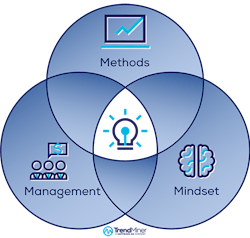Maintenance: Two-Pronged Approach Boosts Operational Excellence
Historically, Huntsman process engineers would use their extensive experience and process knowledge to try to understand sensor-generated data. As such, this approach was experience-driven rather than data-driven. The company wanted to fully leverage the captured sensor-generated data by transforming to a data-driven approach. However, doing so first required overcoming two challenges: one related to data skills and one related to workflow.
In solving the data skills challenge, the organization had to consider the different analytic skills of its process experts and data scientists. Process experts know about production processes and think in terms of trends and their meaning. In contrast, data scientists do not necessarily have production knowledge and think in terms of algorithms and statistical models. Overcoming the disconnect between these two central problem-solving groups was essential.
Huntsman solved this problem by adopting self-service analytics that allowed process experts themselves to do the data analytics, thus moving their data skills closer to those of the data scientists. Self-service analytics democratizes the analytics and the data, enabling these experts to analyze, monitor and predict production processes without the help of data scientists. Therefore, self-service analytics gave the process experts data-driven insights so they could make data-driven decisions.
Figure 1. Successfully adopting a new way of working requires addressing all three.
The next step was to capture a way of working so personnel would successfully adopt and use self-service analytics. To do this required addressing three aspects: mindset, method and management (Figure 1). With any new work approach, personnel must have the mindset to use the new tool and must want to make it a success. To tackle this challenge, we decided to initially concentrate on quick and important wins. Personnel were willing to adopt self-service analytics once they saw its use could substantially ease their work and improve operations. Also, for any new work approach to succeed, you must put in place suitable methods and management. This requires establishing a standardized plan for implementing adoption, including proper support from those in charge. We overcame these two challenges, and the organization went from an experience-driven to a data-driven work approach.
Benefits Of Self-Service Analytics
One way to fully leverage sensor-generated time-series data was to get engineers to become analytics-enabled via tools like TrendMiner’s self-service analytics. This allowed them to go from pure diagnostics to analyses that explained what was behind the trend. It made them much more effective in evaluating trends, searching back in time, and comparing good and bad behavior to come up with solutions for operational problems. Moreover, process experts could compare past patterns to look for good and bad behavior of the production process. They then could save good behaviors as fingerprints and set up monitors to alert personnel via messages, email or dashboards when any deviation from these fingerprints occurred. This monitoring capability created a “24-hour engineering support” system that was extremely helpful because the engineers were not on-site 24/7 (Figure 2).
Additionally, TrendMiner allowed Huntsman’s process experts to set monitors to predict operational performance and send out early warnings, also via messages, about possible deviations. Similarly, it was used for continuous improvement in each phase of the classic define-measure-analyze-improve-control (DMAIC) cycle and in the Six Sigma methodology to achieve operational excellence.
Besides these benefits, self-service analytics also helped eliminate data silos. Like many other chemical manufacturers, Huntsman traditionally kept its operational data in separate silos, each with its specific teams and process/business applications. TrendMiner allowed the team to contextualize and centralize operational data and to save and share these data with the entire team. Eliminating the silos enabled us to move toward combined production overviews for all sites, both locally and globally. With this shared information, global collaboration and team efficiency improved and resulted in enhanced resolution of production problems.
Figure 2. Self-service-analytics monitoring capabilities provide engineering support whenever required.
Success Stories
To better understand how Huntsman has benefited from self-service analytics, let’s look at three specific use cases.
1. Setting soft sensors for monitoring product quality. For years, a continuous isocyanate plant had been collecting daily process and offline-created analysis data and storing everything in the historian database. Early in 2016, using self-service analytics, the company’s teams realized they could build soft sensors based on operating conditions to predict product quality for certain isocyanates. In turn, the process experts used these soft sensors to make micro-adjustments to setpoints to proactively minimize impurity levels. As an example, one of the monitors predicted hydrolyzable chloride levels in the final product; tweaking vacuum pressure conditions mitigated the impact on product quality. In addition, the plant set up monitors to send out early warnings to tell the operators not to load trucks, preventing off-specification material from going to a customer.
Self-service analytics enabled 24/7 quality control — in contrast to the previous quality-control situation that relied on analyses only available during regular weekday work hours. With trucks being sent out seven days per week, the soft sensors eliminated 75% of the expensive off-spec transportation cases that occurred on the weekends. In addition, they provided a significant positive impact on lead time by eliminating unnecessary wait hours for in-spec product, reducing the average lead time by several hours. Finally, the extra insights on product quality also decreased the demand on resources because the number of uncertain situations for this specific product dropped by as much as 10%.
2. Fingerprinting batch processes for checking product quality. The common practice of the team was to check batch profiles using a spreadsheet. This approach required a lot of work, time and expertise. Since the end of 2018, we have applied the self-service analytics feature to create fingerprints to check batch quality against specifications. One of the polyols processes requires distinct pressure and temperature profiles to consistently create high-quality material. To ensure this quality, we grouped time-series patterns from known good batches and saved this as a fingerprint. We use the golden batch fingerprint as a real-time monitor to continuously check the process for deviations.
This fingerprint allowed quick identification of subtle disturbances difficult to capture in a numerical model. Likewise, it eliminated the need to check afterward for any abnormalities because the monitors gave early warnings for unexpected heat input, allowing operators to take appropriate action in time. This new approach to batch analysis and monitoring led to a significant reduction in off-spec batches and an increase in product quality.
3. Quality improvement using self-service analytics capabilities for DMAIC. In one of the advanced materials plants, many batches in a wiped-film evaporator exceeded the solvent limit, resulting in off-spec products. Moreover, this plant had suffered a multi-year drift in quality as measured by the quality assurance lab. It was suspected this issue stemmed from a change in testing methods; however, the frequency of off-spec production demanded a resolution.
So, engineers performed a complete Six-Sigma DMAIC analysis using the various capabilities of the self-service analytics platform. The analysis included using value-based searches, layer comparisons, statistical comparison tables, scatterplots, filtering, and the recommendation engine.
By observing scatter plots, process experts could easily track batch performance to see which batches were inside and which ones were outside the operating zone. This revealed multiple differences between the plant’s on-spec and off-spec production campaigns. The differences were enough to convince subject matter experts that long-term changes were occurring in the process. Further investigation ruled out the misreading of flowmeters, and found a non-negligible offset between measured and true pressure. The self-service analytics allowed the process experts to complete a faster root-cause analysis on a much larger data set. They also were able to identify subtle differences in the pressure readings and, thus, call for conducting more tests. After making process changes based on these findings, quality improvements were confirmed within a few days.
Significant Benefits
Through the adoption and use of TrendMiner’s self-service data analytics, Huntsman has achieved: data-driven insights leading to data-driven decisions; increased employee and plant efficiency; the breakdown of data silos; and a data-driven “24-hour engineering support” system. Ultimately, Huntsman was able to improve process and asset reliability leading to stabler and, therefore, safer plants.
JASPER RUTTEN is advanced analytics manager for Huntsman, Rotterdam, The Netherlands. Email him at [email protected].


